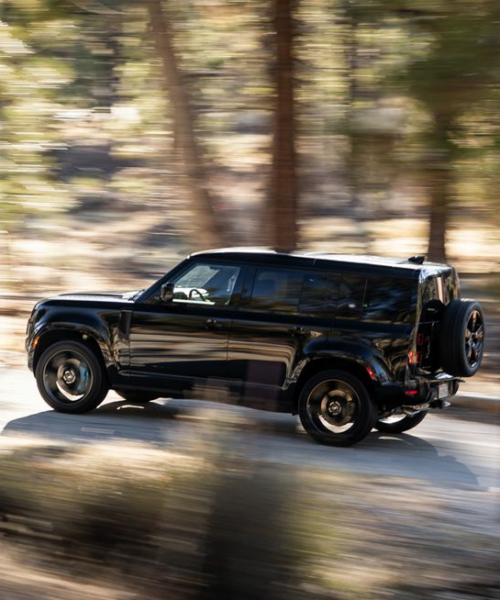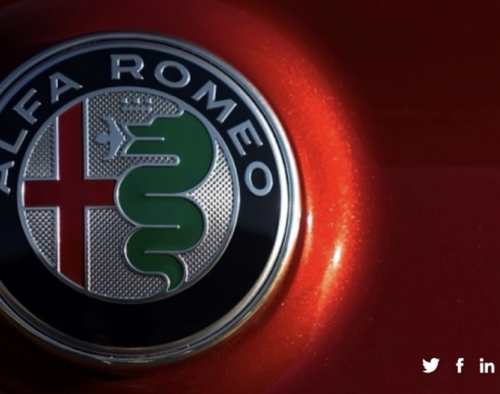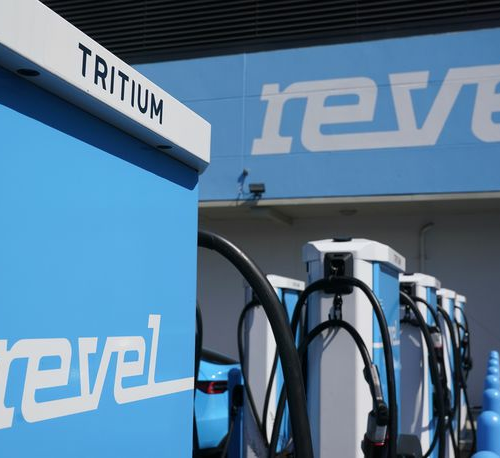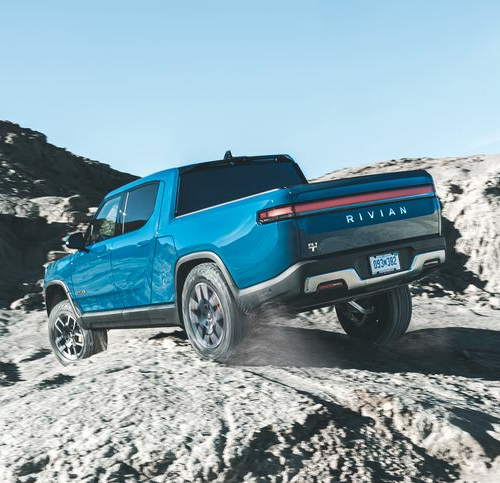BY JOE LORIO | CarAndDriver.Com
Troy Warren for CNT #Cars
The latest Land Rover Discovery may have more off-road ability than most family SUVs, but the brand’s new Defender gets all the glory.
The Discovery spearheaded the return of Land Rover to the United States market, making a name for itself with its rugged, go-just-about-anywhere capability. Now in its fourth generation (the intervening two adopting the LR3 and LR4 monikers here in the States), the Discovery now has a somewhat different mission and must make its case as the brand’s family hauler. Even so, the Discovery’s DNA still includes more off-road capability than others of its ilk, even if the new Defender now wears the brand’s mud-plugging crown.
Powering the Discovery is a choice of two engines. The base unit is Jaguar Land Rover’s turbocharged 2.0-liter four-cylinder, which at 296 horsepower and 295 pound-feet of torque is muscular for a little guy. Available in upper trims such as our tested R-Dynamic S model is a turbocharged 3.0-liter inline-six bolstered by a 48-volt hybrid assist. It makes 355 horsepower and 369 pound-feet of torque. Both engines are bolted to an eight-speed automatic transmission, and all-wheel drive is standard fare.

HIGHS: Genuine off-road ability, placid ride, robust towing capacity.

We have not tested a four-cylinder Discovery, but this turbo-six version reaches 60 mph in 6.3 seconds and dispatches the quarter-mile in 14.7 seconds at 96 mph. Those figures just clip the Acura MDX with its naturally aspirated V-6 but trail the more muscular twin-turbo Lincoln Aviator and the plug-in-hybrid Volvo XC90 T8, as well as turbocharged six-cylinder German competitors such as the Audi Q7, BMW X5 xDrive40i, and Mercedes GLE450. The six-cylinder Disco’s acceleration also roughly matches that of the supercharged and turbocharged Defender. The turbo’s shove comes in a beat after moving off from a stop, but throttle response is otherwise good, even if the smooth-shifting eight-speed can be relaxed about downshifts.
According to the EPA, the six-cylinder Discovery’s fuel-economy estimates of 18/24 mpg city/highway are not much different than the turbo four’s 19/22 mpg, although our observed average was just 17 mpg. And in our real-world, 75-mph highway fuel-economy test, the Discovery returned 22 mpg, which matches the MDX but trails the X5 xDrive40i (28 mpg) and the XC90 T8 (29 mpg). The six also allows the Discovery to tow up to 8200 pounds versus 5952 for the base engine. That hearty towing capacity puts the Land Rover in the company of full-size SUVs such as the Chevy Tahoe and Nissan Armada. And an available Advanced Tow Assist feature brings automated steering for tricky reversing maneuvers.

LOWS: Luggage space disappears with all seats in use, body leans readily in cornering, innocuous styling.
Although the current Discovery’s smooth, wind-shaped bodywork has none of the blocky, top-heavy appearance of the original, it still towers at 74.3 inches, and its on-road dynamic behavior hasn’t entirely left that old model in the past. There’s lots of lateral squish, and the body lists readily in response to quick steering maneuvers. Three-row family SUVs aren’t generally known for their cornering prowess, but the Acura MDX and BMW X5 are far sportier. Around the skidpad, our Discovery managed just 0.79 g of grip, which is well off the pace of the Audi Q7 (0.86 g), BMW X5 (0.89 g), and even a spry mainstream rig such as the Mazda CX-9 (0.85 g). To its credit, though, the Land Rover’s steering is naturally weighted, and its comportment on the street is more refined than the Defender’s. Moreover, the standard air-spring suspension effectively masks bad pavement, delivering a placid ride aided by adaptive dampers in the R-Dynamic S. Stops from 70 mph take a tidy 170 feet, matching the X5 40i, and the Disco’s left pedal feels firm through its travel.

While most Discoverys will spend the bulk of their time pounding pavement, it’s a shame we didn’t have an opportunity to exercise this Land Rover in conditions more challenging than just a little snow. We previously piloted a Discovery at Land Rover’s off-road testing center in the U.K., and it proved remarkably adept through mud and muck. The available two-speed transfer case and electronically locking rear differential are clues that even in its most family-oriented SUV, Land Rover still takes off-road ability seriously. The all-wheel drive’s Terrain Response system features five different off-road settings. Included in that array is a Wade mode that allows the Discovery to drive through water 35.4 inches deep—just the thing for the next superstorm that’s surely around the corner. A full phalanx of exterior cameras is on hand to help avoid rocks and stumps but proves equally clutch when navigating tight garages and street parking. The default view is a useful split screen with overhead and backup views, and, happily, the camera system is included as standard.
Jaguar and Land Rover’s Pivi Pro infotainment system arrived with the 2021 model year and includes an 11.4-inch display, Apple CarPlay and Android Auto connectivity, navigation, a Wi-Fi hotspot, and the ability to receive over-the-air updates. (The recently announced 2023 model adds standard wireless device charging.) The generously sized screen boasts top-notch resolution, the voice recognition system had no problems discerning our Yank accents, and the home screen shows three functions at once. But the lack of any knobs or buttons for radio tuning is a negative (steering-wheel buttons allow for jumping between presets). Hard buttons to select main functions also would be welcome.

Below the display is a pair of multitasking knobs: Turn to set the temperature, push and turn to control seat heating and cooling, pull and turn to adjust fan speed. The remaining climate functions are handled by a panel of touch-sensitive buttons, which are sometimes unresponsive. Behind that panel is a hidden storage cubby, which together with the dual glove boxes and multi-bay console provide plenty of places to stash your stuff. The console also sees the previous dial gear selector replaced by an electronic shift lever, which is a change for the better by our reckoning.
The latest Discovery appears slimmed down compared to its immediate predecessor but is in fact five inches longer and some three inches wider. That bigger box affords a spacious second row that’s adequate for three occupants, and the no-cost optional third row is tolerable for adults or older teens, though its bottom cushion is barely off the floor. The trick is climbing back there, which is far more difficult here than in most competitors. Second-row captain’s chairs would make that task easier, but they’re not offered. When the third-row seat is deployed, it also wipes out nearly all the luggage space, leaving just 9 cubic feet—enough space for just two carry-on-size bags. That’s less than you’ll find in the XC90 (13 cubic feet), the Q7 (14), or the MDX (18). Folding the rearmost seats results in 45 cubes of cargo space, while max cargo volume with both back rows stowed is 74 cubic feet.

The difficult access to the rearmost bench stands in contrast to the other seats, as narrow door sills make it easy to climb aboard without muddying your pant leg. Once inside, one finds a modern, well-finished cabin that’s less overly rugged than the Defender’s. Two-tone leather upholstery as in our test car, or faux-leather, plus brushed-metal trim, conveys an upscale vibe. A panoramic sunroof is standard, and numerous USB ports sprinkled among all three rows keep everyone’s devices charged.
Compared to other three-row family-haulers, the Discovery still has impressive off-road prowess, but it’s traded that image for a more urbane persona. As a result, it’s somewhat overshadowed by its ruggedly handsome sibling inside the Land Rover showroom. Granted, the Defender’s interior is not quite as plush, and its (optional) third row is even less accommodating, but it brings a more authentic safari vibe to the school pickup line that the latest Disco can’t match.
Specifications
2021 Land Rover Discovery P360 R-Dynamic S
Vehicle Type: front-engine, 4-wheel-drive, 7-passenger, 4-door wagon
PRICE
Base/As Tested: $63,250/$72,755
Options: 21-inch Gloss Black wheels, $2000; 18-way front seats, $1350; Meridian Surround Sound System, $1250; Black contrast roof; head-up display, $970; Lantau Bronze Metallic paint, $710; tow hitch receiver, $675; Cold Climate package (heated steering wheel, washer jets, and windshield), $600; premium LED headlights, $400; electric third row seats, $300; automatic high beam assist, $250
ENGINE
turbocharged and intercooled DOHC 24-valve inline-6, aluminum block and head, direct fuel injection
Displacement: 183 in3, 2995 cm3
Power: 355 hp @ 5500 rpm
Torque: 369 lb-ft @ 1750 rpm
TRANSMISSION
8-speed automatic
CHASSIS
Suspension, F/R: multilink/multilink
Brakes, F/R: 14.3-in vented disc/13.8-in vented disc
Tires: Pirelli Scorpion Zero All Season
275/40R-22 108Y LR
DIMENSIONS
Wheelbase: 115.1 in
Length: 195.1 in
Width: 78.7 in
Height: 74.3 in
Passenger Volume: 140 ft3
Cargo Volume: 9 ft3
Curb Weight: 5569 lb
C/D TEST RESULTS
60 mph: 6.3 sec
1/4-Mile: 14.7 sec @ 96 mph
100 mph: 16.1 sec
130 mph: 34.4 sec
Results above omit 1-ft rollout of 0.3 sec.
Rolling Start, 5–60 mph: 6.9 sec
Top Gear, 30–50 mph: 4.1 sec
Top Gear, 50–70 mph: 4.5 sec
Top Speed (gov ltd): 132 mph
Braking, 70–0 mph: 170 ft
Roadholding, 300-ft Skidpad: 0.79 g
C/D FUEL ECONOMY
Observed: 17 mpg
75-mph Highway Driving: 22 mpg
Highway Range: 520 mi
EPA FUEL ECONOMY
Combined/City/Highway: 21/18/24 mpg


































